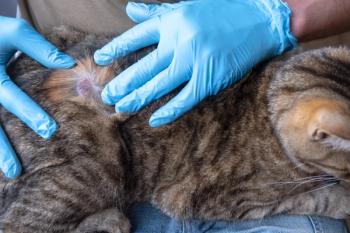
Shelter euthanasia rates drop to historic lows
An estimated 5 million cats and dogs are euthanized in U. S. shelters each year, and while reliable statistics are scarce, experts predict they sharply contrast death tolls recorded as late as 1995.
An estimated 5 million cats and dogs are euthanized in U. S. shelters each year, and while reliable statistics are scarce, experts predict they sharply contrast death tolls recorded as late as 1995.
Merritt Clifton
The success of spay neuter programs has dramatically reduced the number of puppies and kittens relinquished, especially in northern metropolitan shelters, statistics show. But even as the tide turns in the battle against pet overpopulation, experts say the veterinary profession should be doing more.
"Pet overpopulation is an epidemic, and veterinarians should treat it as such," says Peter Marsh, animal population analyst and founder of Solutions to Overpopulation of Pets in New Hampshire. "It's the number one pet killer in the country.
"The key is reducing the number of animals entering the system. Shelters can't adopt themselves out of this problem."
Euthanasia: a measure of pet surplus
To date, no nationwide agency records more comprehensive relinquishment and euthanasia statistics at U.S. shelters than Animal People, an independent newspaper focused on animal protection. Since its inception in 1992, Editor Merritt Clifton and his staff have surveyed shelters nationwide, collecting data from government statistics as well as independent shelter reports for a look at roughly 51 percent of shelters running today. The results: 7.5 million dogs and cats are taken in each year with 4.4 million euthanized due largely to surplus. Two-thirds of the intakes are cats. Half of all dogs relinquished are adopted out or returned to owners, Clifton reports.
Table 1: Top 10 reasons for pet relinquishment among shelters in the united states.
"Seventy-five percent of those cats are feral with a re-home rate of 3 or 4 percent," he says. "It's not good, but it's better than it used to be."
Statistically speaking
Shelter data is scarce because organizations, whether private or publicly run, often aren't required to supply states with records of animals entering and leaving the system. In 1970, Los Angeles became one of the first cities to track such data, reporting that 115 dogs and cats were killed for every 1,000 U.S. residents. Thirteen years later, the city's euthanasia rate had dropped drastically, largely due to a movement to sterilize pets. Intakes recorded that year were 94,698, compared to 144,530 in 1970.
But it was another two years before a national survey was done. In 1985, American Humane Association reported 17.8 million shelter deaths in the United States.
"Since then, there's never been an increase in those numbers since we've tracked the data," Clifton reports. "Over 35 years, that's an enormous improvement."
A look at cat overpopulation
Still, it's not enough, says Dr. Judy Dinnage, director of Animal Protection Medicine with the Massachusetts Society for the Prevention of Cruelty to Animals (MSPCA).
Dr. Phil Kass
It's kitten season, and right now, 30,000 animals are housed yearly in the MSPCA's seven shelters. In a state ranked by the American Veterinary Medical Association as 50th in the United States in terms of dog ownership, most program residents are cats with minimal chances for adoption, Dinnage says.
"Cats are our biggest problem in Massachusetts," she says. "With dogs, our adoption rate is over 50 percent. It's much lower with our cats. Just 25 to 35 percent of our cats are ever re-homed."
The same goes for San Francisco, where the SPCA receives animals not adopted from the city's shelter system, says Dr. David Stein, a veterinarian with the program.
While the Massachusetts and San Francisco SPCAs only euthanize animals for specific behavior of quality of life concerns, the number of cats is a problem. Still, the drop in San Francisco's stray or feral cat population is a success story in the making, Stein says.
"The city shelter used to take in close to 30,000 animals a year. Now it's 8,000," he says. "That's largely due to aggressive spay and neuter programs, which have cut down on the population problem. Last year, we sterilized 2,200 feral cats. We started doing that 11 years ago."
Mandate of sterilization
Veterinarians have clearly embraced the concept of sterilization and recognized the value of it. Their work is evident in draining shelter intake numbers coming in from underserved populations, says Dr. Gary Patronek, who attributes the success largely to subsidized sterilization programs.
"It's a broad cultural acceptance," says Patronek, director of the Center for Animals and Public Policy at Tufts University. "For the majority of pet owners, it's just what you do, and that has made a huge difference."
There also is much greater rejection of euthanasia as a population control measure, Patronek adds.
"There have been a lot of groups promoting sterilization, including these feral cat groups that are trapping and neutering feral cats," he says. "You have incredibly well-organized and concerted efforts for underserved populations. The feral cat trap and release is systematic sterilization that has never been done before."
Breakdown of the bond
Even with new sterilization measures, there are plenty of reasons why animals turn up in shelters. The National Council on Pet Population Study and Policy reports that relinquishment to shelters is a complex decision, often believed to represent a breakdown of the human-animal bond (see Table 1).
Whether allergies, relocation or cost of pet maintenance, the top reasons have nothing to do with behavior, notes Heather Commisa, executive director of the Jersey Shore Animal Shelter in Brick, N.J.
"We run into people all the time who tell us they're already feeling uncomfortable with what they're doing, but they have allergies," Commisa says. "Doctors often say, 'get rid of the pet.' I would really love to see the medical community work with us to keep pets at home, but they don't."
Seasonal relinquishment also is an issue, she says.
"Every year we see it," Commisa says. "We have a lot of people come into the shelter prior to Christmas and ask if we have any puppies. People don't do their research. We find that someone will research buying a washing machine for three months, but they'll go right out and buy a puppy just because it's cute."
Impulse pet purchases often don't work out because buyers view pets as disposable, failing to take time to meet behavior needs and address issues, says Dr. Phil Kass, associate professor of epidemiology at University of California Davis School of Veterinary Medicine.
Kass has published numerous articles concerning pet surplus and euthanasia related to overpopulation and relinquishment.
"In my research, I've found that people view animal shelters as the equivalent of a thrift shop," he says. "Despite lower euthanasia numbers, shelter animals are very likely to turn up dead."
Newsletter
From exam room tips to practice management insights, get trusted veterinary news delivered straight to your inbox—subscribe to dvm360.




